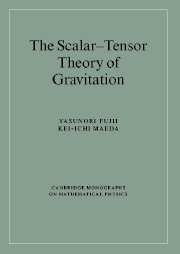Book contents
- Frontmatter
- Contents
- Preface
- Conventions and notation
- 1 Introduction
- 2 The Prototype Brans–Dicke model
- 3 Conformal transformation
- 4 Cosmology with Λ
- 5 Models of an accelerating universe
- 6 Quantum effects
- Appendix A The scalar field from Kaluza-Klein theory
- Appendix B The curvature scalar from the assumed two-sheeted space-time
- Appendix C The field equation of gravity in the presence of nonminimal coupling
- Appendix D The law of conservation of matter
- Appendix E Eddington's parameters
- Appendix F Conformal transformation of a spinor field
- Appendix G Conformal transformation of the curvature scalar
- Appendix H A special choice for conformal invariance
- Appendix J The matter energy–momentum nonconservation law in the E frame
- Appendix K A modification to the Λ term
- Appendix L Einstein's equation in the brane world
- Appendix M Dilatation current
- Appendix N Loop integrals in continuous dimensions
- Appendix O A conformal frame in which particle masses are finally constant
- References
- Index
Preface
Published online by Cambridge University Press: 24 August 2009
- Frontmatter
- Contents
- Preface
- Conventions and notation
- 1 Introduction
- 2 The Prototype Brans–Dicke model
- 3 Conformal transformation
- 4 Cosmology with Λ
- 5 Models of an accelerating universe
- 6 Quantum effects
- Appendix A The scalar field from Kaluza-Klein theory
- Appendix B The curvature scalar from the assumed two-sheeted space-time
- Appendix C The field equation of gravity in the presence of nonminimal coupling
- Appendix D The law of conservation of matter
- Appendix E Eddington's parameters
- Appendix F Conformal transformation of a spinor field
- Appendix G Conformal transformation of the curvature scalar
- Appendix H A special choice for conformal invariance
- Appendix J The matter energy–momentum nonconservation law in the E frame
- Appendix K A modification to the Λ term
- Appendix L Einstein's equation in the brane world
- Appendix M Dilatation current
- Appendix N Loop integrals in continuous dimensions
- Appendix O A conformal frame in which particle masses are finally constant
- References
- Index
Summary
During the last few decades of the twentieth century, we saw an almost triumphant success in establishing that Einstein's general relativity is correct, both experimentally and theoretically. We find nevertheless considerable efforts still being made in terms of “alternative theories.” This trend may be justified insofar as the scalar–tensor theory is concerned, as will be argued, not to mention one's hidden desire to see nature's simplest imaginable phenomenon, a scalar field, be a major player.
The success on the theoretical front prompted researchers to study theories with the aim of unifying gravitation and microscopic physics. Among them string theory appears to be the most promising. According to this theory, the graviton corresponding to the metric tensor has a scalar companion, called the dilaton. The interaction between these two fields is surprisingly similar to what Jordan foresaw nearly half a century ago, without sharing ideas that characterize the contemporary unification program. There seems to be, however, a crucial point that might constrain the original proposal through the value of the parameter ω, whose inverse measures the strength of the coupling of the scalar field.
More specifically, string theory predicts that ω = –1, which goes against the widely accepted constraint from observation, namely ω ≳ 103 ≫ 1. Although many more details have yet to be worked out in order for string theory to be compared with the real world, we point out that expecting the dilaton to be close to the limit of total decoupling is by no means obvious or natural.
- Type
- Chapter
- Information
- The Scalar-Tensor Theory of Gravitation , pp. xi - xiiiPublisher: Cambridge University PressPrint publication year: 2003

